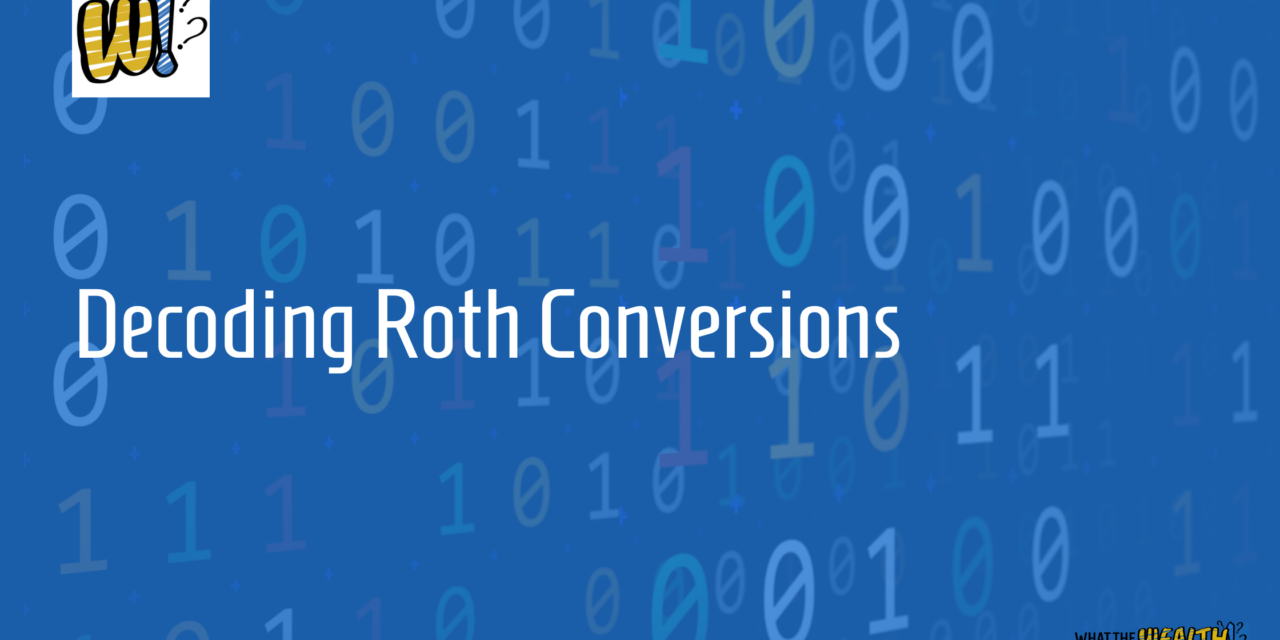Decoding Roth Conversions: A Deep Dive Into Strategies, Myths, and Tax Implications
A Roth conversion can be a valuable part of your financial planning toolbox. In episode 87 of the Wealth the Wealth podcast, we’ll discuss what you need to know if you’re considering doing a Roth conversion.
What is a Roth Conversion?
A Roth IRA conversion is when you transfer retirement assets from a Traditional IRA (or SEP, SIMPLE IRA, or 401(k) into a Roth IRA.
Benefits of Roth IRA Conversions
Arguably, the most significant benefit of doing a Roth conversion is that the money in the account grows tax-free from the moment of the conversion forward. This is important because while none of us can accurately predict the future, we can look at a couple of indicators suggesting taxes are likely to rise.
The national debt has dramatically increased, which means the interest on it has also increased. This has to be addressed at some point, and higher taxes will almost certainly be part of the plan to do so.
Social Security is another factor. A few decades ago, there were 12 workers for each Social Security recipient. Now, there are just 2.5 workers for each recipient. Again, an increase in taxes will likely be part of the solution to this imbalance.
RMDs and eligibility requirements are two additional benefits to a Roth conversion, which we’ll discuss further.
Things to Consider When Doing a Roth Conversion
Before deciding whether or not a Roth conversion is suitable for your financial plan, there are things to consider.
Liquidity
Having an emergency fund, three to nine months’ worth of essential expenses, depending on your situation, is an important cornerstone of a healthy financial life, and you want that in place before considering a Roth conversion.
A Roth conversion is a taxable event, so you want to be sure you have the capital to account for that. The amount of the tax liability depends on your tax bracket, and if you live in a state with income tax, you’ll have to pay both state and federal taxes on the conversion.
Conversion Method
There are two ways to do a Roth conversion. The most popular is a direct conversion. You sign a document stating you want to convert directly from one account to another, and the custodian handles the transfer of funds. This is the easiest method and what we typically recommend for our clients.
The other method is a 60-day rollover. You’ll get a check in the amount of the funds being transferred. You have a 60-day window to send the check to the custodian of the new Roth account. It’s important not to cash the check. Doing so will create a taxable event. This method typically happens when there are two custodians involved, one for the original account and one for the Roth account, whereas the direct method involves a single custodian doing an internal transfer.
Timing
I’m not a fan of trying to time the market, but timing a Roth conversion can be impactful. Doing a Roth conversion when the market is down, 20% to 25%, as it was in 2022, for example. When you convert, you’re converting on the account’s value at the time of the conversion.
If the assets you’re converting are down, you’re converting at a cheaper valuation, so your tax liability will be less. This allows you to move into a Roth and allow the account to recover in that Roth, where the assets will grow tax-free.
Eligibility and Limitations
There are income thresholds to contribute directly to a Roth IRA, so some people will be phased out. There are no income thresholds or other limitations when doing a Roth conversion. You can do a direct conversion, no matter your income. This is a significant benefit for those who are otherwise phased out.
RMDs
Required minimum distributions (RMD) are the amount of money that you must withdraw each year from certain retirement accounts, including Tradtional IRAs. The age at which RMDs must be taken changes from time to time. Currently, the age is 73. Roth IRAs are not subject to RMD whether the money in the account was from direct contributions or a conversion.
It’s Permanent
In 2017, as part of the Tax Cuts and Jobs Act, the ability to “recharacterize” Roth conversions was eliminated. What this means is that once you do the conversion, you can’t change your mind and convert back to a Traditional IRA. Once you’re converted, you’re locked in, so make sure the conversion fits into your overall financial plan and you can handle the tax implications.
Cost and Fees
Sometimes, custodians charge an administrative fee, usually $25, to do a Roth conversion. While this is not the biggest consideration, and the power of your money growing tax-free may outweigh it, it is something to be aware of.
Paperwork
When you do a Roth conversion, it’s considered a distribution from a pre-tax, Traditional IRA. You will receive a 1099-R form that you will need to submit with your tax return. This form tells the IRS that money came from your Traditional IRA and is a taxable event.
The other form you’ll receive is a Form 5498. This form will show that the distribution from your Traditional IRA was rolled over into a Roth IRA.
Rules to Follow
In order to benefit from a Roth conversion, you’ll need to be sure you follow all of the required rules for tax-free growth. Roth IRAs are subject to something called the five-year rule. According to the rule, you cannot withdraw earnings tax-free until it’s been at least five years since the first contribution, whether that is a direct contribution or a conversion.
The other rule is age-related. You can withdraw contributions from a Roth IRA before age 59 1/2 without being subject to a penatly but not the gains in the account.
Is a Roth Conversion Right For You?
There are a lot of things in play when considering a Roth conversion. Generally, they are beneficial, but if you’re unsure, reach out to me or your financial advisor for further clarification. A Roth conversion makes sense for a lot of people, but it’s not something you should do on a whim. Before making any decisions, ensure the strategy fits into your financial plan and will benefit you in the long term.
If you enjoyed the podcast, check out my new YouTube channels. The videos are short, walk and talks, where I take a stroll and talk about whatever’s on my mind. I also have a Paradigm Wealth Partners channel and have recently created an Instagram page.
This information is not intended to be a substitute for specific individualized tax or legal advice. We suggest that you discuss your specific situation with a qualified tax or legal advisor.
Traditional IRA account owners have considerations to make before performing a Roth IRA conversion. These primarily include income tax consequences on the converted amount in the year of conversion, withdrawal limitations from a Roth IRA, and income limitations for future contributions to a Roth IRA. In addition, if you are required to take a required minimum distribution (RMD) in the year you convert, you must do so before converting to a Roth IRA.




